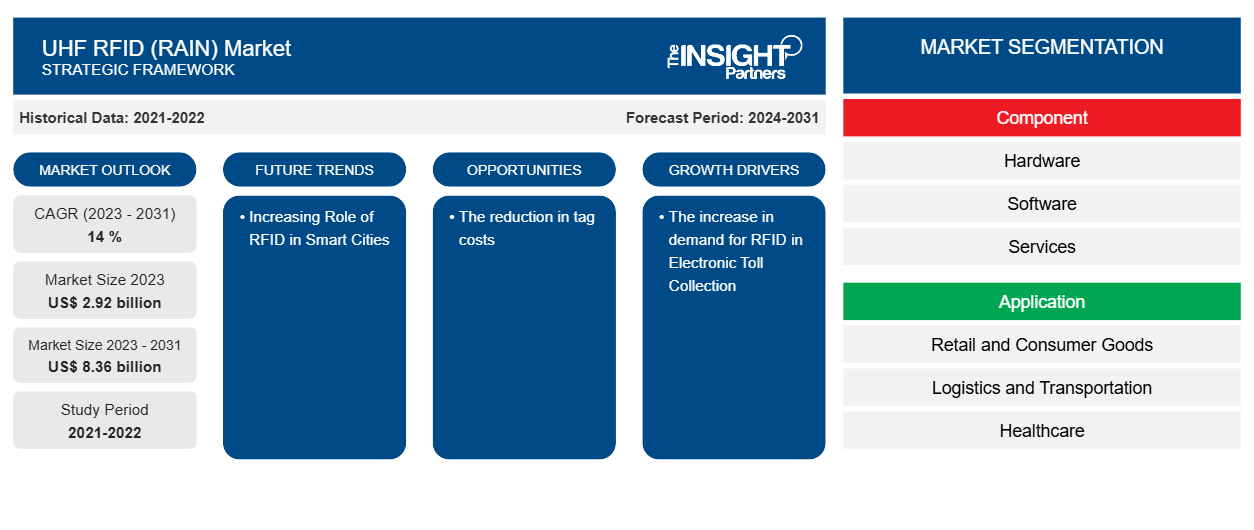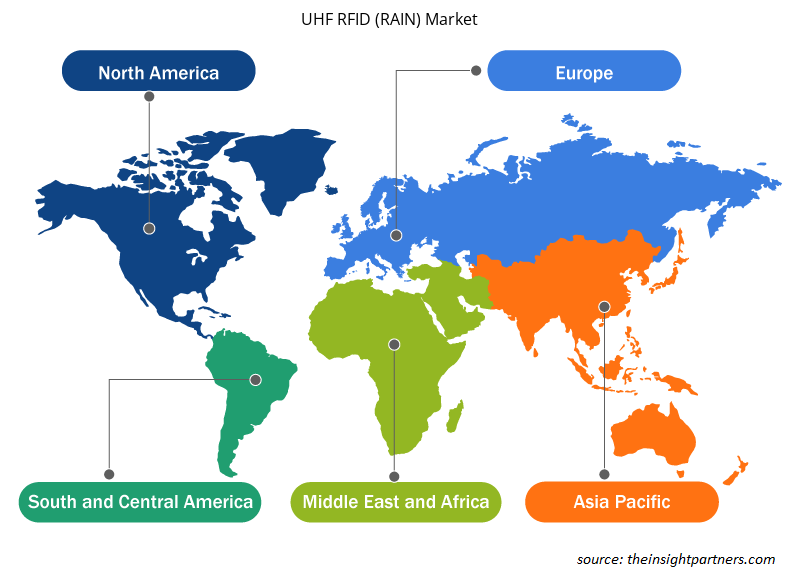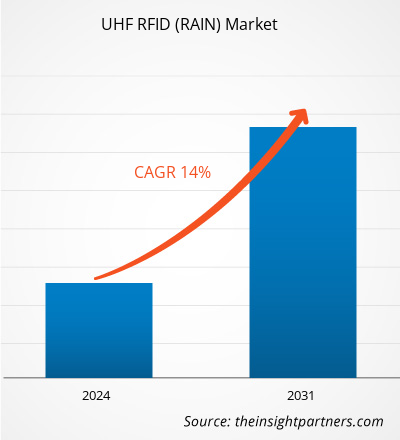Si prevede che il mercato UHF RFID (RAIN) raggiungerà i 14,07 miliardi di dollari entro il 2031, rispetto ai 4,62 miliardi di dollari del 2024. Si prevede che il mercato registrerà un CAGR del 17,9% nel periodo 2025-2031. La crescente adozione nel settore automobilistico porterà probabilmente nuove tendenze nel mercato nei prossimi anni.
Analisi di mercato UHF RFID (RAIN)
RAIN (UHF RFID) è una tecnologia wireless che consente ad aziende e consumatori di identificare, localizzare, verificare e interagire con prodotti di uso comune connettendoli a Internet. Lo spettro RAIN rientra nella banda superiore (tra 860 e 960 MHz) della gamma di frequenze ultra-alte della tecnologia RFID ed è conforme a standard e protocolli specifici. RAIN RFID è una tecnologia passiva, senza batteria, che opera a frequenze ultra-alte (UHF) ed è in grado di identificare oggetti da distanze fino a 15 metri. Può riconoscere fino a 1.000 oggetti al secondo, anche in assenza di una linea di vista diretta. La tecnologia RAIN gestisce i dati, interviene e legge e scrive gli oggetti taggati tramite un lettore. Queste funzionalità consentono ad aziende e clienti di riconoscere, trovare, verificare e interagire con ogni oggetto dotato di tag RAIN. RAIN offre dati e approfondimenti completi e in tempo reale per applicazioni quali l'ottimizzazione della supply chain, il tracciamento delle risorse e la gestione dell'inventario.
Panoramica del mercato UHF RFID (RAIN)
RAIN RFID viene utilizzato nei mercati per identificare, localizzare e autenticare efficacemente i beni. Si distingue dalle altre tecnologie IoT per la sua disponibilità, convenienza e facilità d'uso. La capacità di RAIN RFID di aumentare la visibilità e fornire dati precisi lo rende un punto di svolta nell'era digitale.
Personalizza questo report in base alle tue esigenze
Riceverai la personalizzazione gratuita di qualsiasi report, incluse parti di questo report, analisi a livello nazionale, pacchetto dati Excel e potrai usufruire di fantastiche offerte e sconti per start-up e università.
Mercato UHF RFID (RAIN): approfondimenti strategici

-
Scopri le principali tendenze di mercato di questo rapporto.Questo campione GRATUITO includerà analisi di dati che spaziano dalle tendenze di mercato alle stime e alle previsioni.
Driver e opportunità del mercato UHF RFID (RAIN)
Crescente adozione delle tecnologie RFID nel settore della vendita al dettaglio
Gli sviluppi nelle tecnologie di tracciamento degli inventari e l'attenzione rivolta agli strumenti di marketing online, come gli annunci di Facebook e Google, stanno trainando la crescita del settore retail. Si tratta di uno dei settori maturi negli Stati Uniti, dove i consumatori sono propensi allo shopping online. Secondo i dati pubblicati dall'Ufficio del Censimento del Dipartimento del Commercio, le vendite al dettaglio tramite e-commerce negli Stati Uniti hanno raggiunto i 1.192,6 miliardi di dollari nel 2024, con un aumento dell'8,1% rispetto al 2023.
Nel settore retail, l'identificazione a radiofrequenza (RFID) viene adottata per l'etichettatura dei capi di abbigliamento . I fornitori di abbigliamento stanno integrando la digitalizzazione e l'analisi dei Big Data nelle applicazioni RFID. La tecnologia RFID utilizza le onde radio per trasmettere i dati dai tag RFID a un lettore, consentendo l'identificazione degli oggetti in base ai dati ricevuti e facilitando il tracciamento della loro posizione. Le aziende sono alla ricerca di soluzioni convenienti che consentano loro di aumentare l'efficienza operativa e ridurre i costi generali. I dati di Accenture mostrano che il 93% dei rivenditori nordamericani utilizza la tecnologia RFID in qualche modo per raggiungere questi obiettivi. I giganti del settore retail, come H&M, Lululemon, Zara e Nike, utilizzano la tecnologia RFID UHF per la gestione dell'inventario, aiutandoli a mantenere una catena di approvvigionamento efficiente, contrastare la contraffazione e prevenire situazioni di esaurimento scorte. Nel 2020, Walmart ha imposto ai suoi fornitori di abbigliamento di applicare etichette RFID sui loro prodotti. Nel 2022, l'obbligo è stato esteso a giocattoli, elettronica e altri articoli per la casa. Nel 2023 e nel 2024, l'obbligo si estenderà a tutto, dalle forniture per l'automotive ai prodotti sportivi. Entro il 2025, si prevede che la maggior parte delle altre categorie di prodotti vendute nei negozi Walmart sarà coperta dal requisito. L'implementazione di tali iniziative nel settore retail traina la crescita del mercato in questo segmento. RFID) is adopted for digitalization and Big Data analytics in RFID applications. RFID technology utilizes radio waves to transmit data from RFID tags to a reader, enabling the identification of objects based on the received data and facilitating the tracking of their locations. Organizations are seeking affordable solutions that enable them to increase operational efficiencies and reduce overhead costs. Data from Accenture shows that 93% of North American retailers are using RFID in some capacity to achieve these goals. Retail sector giants, such as H&M, Lululemon, Zara, and Nike, use UHF RFID technology for inventory management, helping them maintain an effective supply chain, combat counterfeit items, and prevent out-of-stock situations. Walmart mandated its clothing suppliers to attach RFID labels on their products in 2020. In 2022, the mandate was extended to cover toys, electronics, and other home items. The mandate expanded to cover everything from automotive supply to sporting products in 2023 and 2024. By 2025, the majority of other product categories that are sold in Walmart stores are expected to be covered by the requirement. The implementation of such initiatives in the retail sector drives the market growth in the segment.
Implementazione della tecnologia RFID UHF nei dispositivi IoT
L'adozione di dispositivi intelligenti e gli investimenti governativi, soprattutto in paesi come Giappone, Singapore, Cina e Australia, focalizzati su ricerca e sviluppo e installazioni dell'Internet of Things (IoT) in settori quali manifatturiero, servizi di pubblica utilità e commercio al dettaglio, stanno alimentando la crescita dell'IoT. Le applicazioni IoT richiedono una connessione dati tra il mondo fisico e quello digitale, e la tecnologia RFID UHF viene utilizzata per collegare questi spazi. Con il boom dell'IoT, la maggior parte degli oggetti in rete sarà connessa in modalità wireless tramite la tecnologia RFID UHF passiva, che consente agli oggetti passivi di comunicare dati cruciali, utilizzabili per identificare tali oggetti con dettagli esatti di luogo e tempo. La tecnologia aggiunge intelligenza all'ecosistema IoT e semplifica le nuove applicazioni per le risorse connesse.
A luglio 2023, Impinj, Inc. ha rilasciato i chip tag RFID RAIN della serie Impinj M800 per supportare le implementazioni IoT, migliorando la connettività degli oggetti per le aziende. Questi chip migliorano la leggibilità, l'affidabilità e la producibilità, migliorando la velocità, la portata e l'affidabilità dei sistemi RFID RAIN nel tracciamento e nella protezione degli oggetti connessi. Questa integrazione aiuta le aziende a prendere decisioni informate basate su informazioni accurate. Collegando i tag RFID a Internet, le aziende possono raccogliere dati sulla posizione degli oggetti, sui modelli di utilizzo e sulle condizioni ambientali, che possono essere utilizzati per analisi predittive . Pertanto, si prevede che l'integrazione della tecnologia RFID UHF nei dispositivi IoT genererà future opportunità di crescita nel mercato.
Analisi della segmentazione del rapporto di mercato UHF RFID (RAIN)
I segmenti chiave che hanno contribuito alla derivazione dell'analisi di mercato UHF RFID (RAIN) sono i componenti e le applicazioni.
- In base al componente, il mercato globale UHF RFID (RAIN) è segmentato in hardware, software e servizi. Nel 2024, il segmento hardware deteneva la quota maggiore del mercato UHF RFID (RAIN).
- Per applicazione, il mercato UHF RFID (RAIN) è segmentato in settori quali vendita al dettaglio e beni di consumo, logistica e trasporti, sanità, produzione, automotive, aerospaziale e difesa, tra gli altri. Nel 2024, il segmento Retail e Beni per il Commercio deteneva la quota maggiore del mercato UHF RFID (RAIN).
Analisi della quota di mercato UHF RFID (RAIN) per area geografica
L'ambito geografico del rapporto di mercato UHF RFID (RAIN) è suddiviso principalmente in cinque regioni: Nord America, Asia Pacifico, Europa, Medio Oriente e Africa, e Sud e Centro America.
Il Nord America ha detenuto una quota di mercato significativa nel 2024. Stati Uniti, Canada e Messico sono tra i paesi chiave del Nord America. Secondo la Federal Communications Commission (FCC), le bande UHF RFID nella regione operano sullo spettro 902-928 MHz, con i lettori che trasmettono alla massima potenza per la maggior parte di tale larghezza di banda. In Nord America, la tecnologia RFID viene adottata nel settore della vendita al dettaglio per trasferire dati da tag applicati agli oggetti tramite un sistema di scansione wireless; questa configurazione serve principalmente allo scopo di identificazione e tracciamento automatici. La facilità di tracciamento, i bassi costi e l'efficace gestione dell'inventario stanno guidando l'adozione di questa tecnologia nel settore della vendita al dettaglio in Nord America. Secondo l'International Trade Administration (ITA), nel 2022 in Canada si contavano oltre 27 milioni di utenti di e-commerce, pari al 75% della popolazione canadese. Si prevede che questo numero salirà al 77,6% nel 2025.
Il crescente settore della vendita al dettaglio in Nord America sta aumentando la domanda di tecnologia RFID UHF per tracciare in modo efficiente i propri inventari. Pertanto, le aziende sono fortemente propense a sviluppare questa tecnologia per soddisfare le crescenti esigenze del settore retail. A maggio 2022, Avery Dennison Corporation ha lanciato due nuovi prodotti alla sua gamma di inserti RFID a doppia frequenza (DF) in continua espansione, che offrono funzionalità combinate NFC (HF) e RAIN RFID (UHF) per l'etichettatura a livello di articolo in modo compatto ed economico. I nuovi inserti e tag AD Medio Web DF EM4425 e AD Web DF EM4425 V12 sono progettati per la protezione del marchio, la gestione della supply chain e il coinvolgimento dei clienti. AD Medio Web DF è stato sviluppato per applicazioni farmaceutiche e sanitarie, mentre AD Web DF si concentra sui casi d'uso nel settore retail. Basati sulla linea di prodotti di successo AD Web RAIN RFID di Avery Dennison, entrambi i prodotti combinano prestazioni eccellenti con un'esclusiva capacità a doppia frequenza. Operando nelle gamme di frequenza RFID HF e UHF, offrono notevoli vantaggi in termini di costi rispetto all'utilizzo di due inserti separati a frequenza singola.RFID technology to track their inventory efficiently. Hence, companies are highly inclined to develop this technology to cater to the growing needs of the retail sector. In May 2022, Avery Dennison Corporation launched two additions to its expanding dual-frequency (DF) range of RFID inlays, which offer combined NFC (HF) and RAIN RFID (UHF) functionality for item-level tagging in a small, cost-effective way. The new AD Medio Web DF EM4425 and AD Web DF EM4425 V12 inlays and tags are designed for brand protection, supply chain management, and customer engagement. AD Medio Web DF has been developed for pharmaceuticals and healthcare applications, while AD Web DF focuses on retail use cases. Based on Avery Dennison's successful AD Web RAIN RFID product line, both products combine excellent performance with a unique dual-frequency capability. Operating in HF and UHF RFID frequency ranges, they offer significant cost advantages compared to using two separate, single-frequency inlays.
Approfondimenti regionali sul mercato UHF RFID (RAIN)
Le tendenze e i fattori regionali che hanno influenzato il mercato UHF RFID (RAIN) durante il periodo di previsione sono stati ampiamente illustrati dagli analisti di Insight Partners. Questa sezione illustra anche i segmenti e la geografia del mercato UHF RFID (RAIN) in Nord America, Europa, Asia-Pacifico, Medio Oriente e Africa, e Sud e Centro America.

- Ottieni i dati specifici regionali per il mercato UHF RFID (RAIN)
Ambito del rapporto di mercato UHF RFID (RAIN)
| Attributo del report | Dettagli |
|---|---|
| Dimensioni del mercato nel 2024 | 4,62 miliardi di dollari USA |
| Dimensioni del mercato entro il 2031 | 14,07 miliardi di dollari USA |
| CAGR globale (2025-2031) | 17,9% |
| Dati storici | 2021-2023 |
| Periodo di previsione | 2025-2031 |
| Segmenti coperti |
Per componente
|
| Regioni e paesi coperti |
America del Nord
|
| Leader di mercato e profili aziendali chiave |
|
Densità degli operatori del mercato UHF RFID (RAIN): comprendere il suo impatto sulle dinamiche aziendali
Il mercato UHF RFID (RAIN) è in rapida crescita, trainato dalla crescente domanda degli utenti finali, dovuta a fattori quali l'evoluzione delle preferenze dei consumatori, i progressi tecnologici e una maggiore consapevolezza dei vantaggi del prodotto. Con l'aumento della domanda, le aziende stanno ampliando la propria offerta, innovando per soddisfare le esigenze dei consumatori e capitalizzando sulle tendenze emergenti, alimentando ulteriormente la crescita del mercato.
La densità degli operatori di mercato si riferisce alla distribuzione delle imprese che operano in un determinato mercato o settore. Indica quanti concorrenti (operatori di mercato) sono presenti in un determinato spazio di mercato in relazione alle sue dimensioni o al suo valore totale.
Le principali aziende che operano nel mercato UHF RFID (RAIN) sono:
- Caen RFID SRL
- Convergence Systems Limited
- Impinj, Inc.
- Invengo Technology PTE. LTD.
- Jadak
- Lowry Solutions Inc.
Disclaimer : le aziende elencate sopra non sono classificate secondo alcun ordine particolare.

- Ottieni una panoramica dei principali attori del mercato UHF RFID (RAIN)
Notizie di mercato e sviluppi recenti sul RFID UHF (RAIN)
Il mercato UHF RFID (RAIN) viene valutato raccogliendo dati qualitativi e quantitativi a seguito di ricerche primarie e secondarie, che includono importanti pubblicazioni aziendali, dati di associazioni e database. Di seguito sono elencati alcuni degli sviluppi nel mercato UHF RFID (RAIN):
- Avery Dennison ha annunciato l'ampliamento della sua gamma AD Pure, un portfolio di inserti e tag completamente privi di plastica PET. Gli inserti e i tag AD Pure sono prodotti in modo sostenibile grazie a un'innovativa tecnologia di produzione delle antenne. L'antenna e i chip vengono applicati direttamente sulla carta, rendendo la gamma completamente priva di plastica. (Fonte: Avery Dennison, comunicato stampa, aprile 2024)
- Checkpoint Systems ha acquisito sistemi di allerta per rafforzare il proprio portfolio di soluzioni per contrastare la criminalità organizzata nel commercio al dettaglio, con particolare attenzione al rilevamento di metalli e magneti nel settore retail. (Fonte: Checkpoint Systems, comunicato stampa, aprile 2023)
Copertura e risultati del rapporto di mercato UHF RFID (RAIN)
Il rapporto "Dimensioni e previsioni del mercato UHF RFID (RAIN) (2021-2031)" fornisce un'analisi dettagliata del mercato che copre le seguenti aree:
- Dimensioni e previsioni del mercato UHF RFID (RAIN) a livello globale, regionale e nazionale per tutti i principali segmenti di mercato coperti dall'ambito
- Tendenze del mercato UHF RFID (RAIN), nonché dinamiche di mercato quali driver, restrizioni e opportunità chiave
- Analisi PEST e SWOT dettagliate
- Analisi di mercato UHF RFID (RAIN) che copre le principali tendenze del mercato, il quadro globale e regionale, i principali attori, le normative e i recenti sviluppi del mercato
- Analisi del panorama industriale e della concorrenza che copre la concentrazione del mercato, l'analisi della mappa di calore, i principali attori e gli sviluppi recenti per il mercato UHF RFID (RAIN)
- Profili aziendali dettagliati
- Analisi storica (2 anni), anno base, previsione (7 anni) con CAGR
- Analisi PEST e SWOT
- Valore/volume delle dimensioni del mercato - Globale, Regionale, Nazionale
- Industria e panorama competitivo
- Set di dati Excel
Report recenti
Testimonianze
Motivo dell'acquisto
- Processo decisionale informato
- Comprensione delle dinamiche di mercato
- Analisi competitiva
- Analisi dei clienti
- Previsioni di mercato
- Mitigazione del rischio
- Pianificazione strategica
- Giustificazione degli investimenti
- Identificazione dei mercati emergenti
- Miglioramento delle strategie di marketing
- Aumento dell'efficienza operativa
- Allineamento alle tendenze normative






















 Ottieni un campione gratuito per - Mercato UHF RFID (RAIN)
Ottieni un campione gratuito per - Mercato UHF RFID (RAIN)